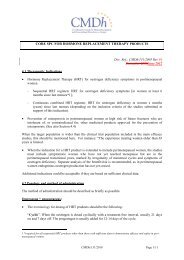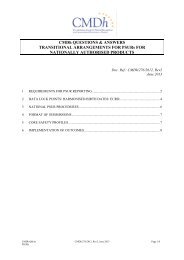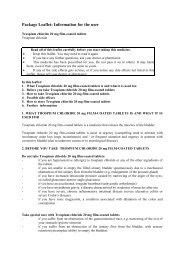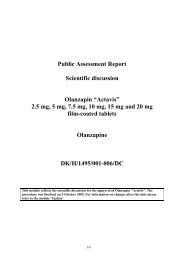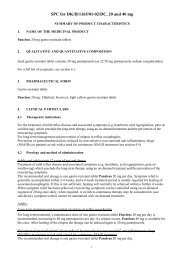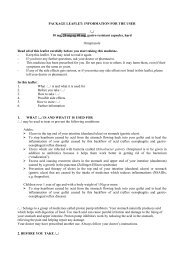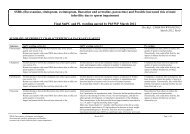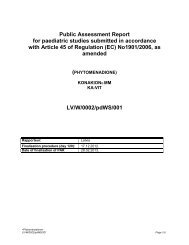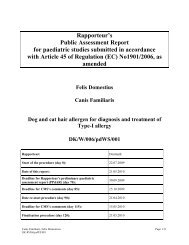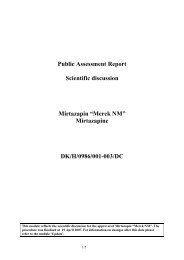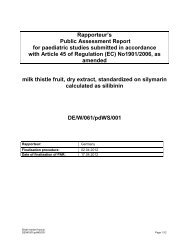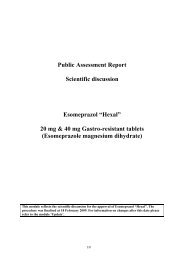Public Assessment Report for paediatric studies submitted in ...
Public Assessment Report for paediatric studies submitted in ...
Public Assessment Report for paediatric studies submitted in ...
Create successful ePaper yourself
Turn your PDF publications into a flip-book with our unique Google optimized e-Paper software.
Assessor’s comment<br />
The sample size is small and 8 subjects could not be assessed by peak expiratory flow. The study<br />
design was poor as the assessment of cl<strong>in</strong>ical status was not assessed as accurately as other<br />
measurements. These facts limit the significance of the f<strong>in</strong>d<strong>in</strong>gs.<br />
The study was very old (1984) and the latest <strong>paediatric</strong> guidel<strong>in</strong>es (2009) do not provide any<br />
<strong>in</strong><strong>for</strong>mation about these routes of adm<strong>in</strong>istration <strong>in</strong> acute exacerbation of asthma. These routes of<br />
adm<strong>in</strong>istration of salbutamol might be of little cl<strong>in</strong>ical importance <strong>in</strong> such cases.<br />
The reported adverse events are known to be associated with the use of salbutamol (<strong>in</strong>crease of<br />
heart rate and blood pressure) and not very well <strong>in</strong>vestigated (eg ECG); there was no report of a new<br />
one.<br />
There isn’t any document to certify that the study has been conducted <strong>in</strong> accordance with GCP.<br />
In conclusion, this study does not provide robust evidence on the efficacy and safety of<br />
<strong>in</strong>tramuscular or subcutaneous salbutamol adm<strong>in</strong>istrated <strong>in</strong> a dose of 8 µg/kg to children with an acute<br />
exacerbation of asthma.<br />
Study D78/B24<br />
A comparison of <strong>in</strong>travenous salbutamol, am<strong>in</strong>ophyl<strong>in</strong>e and the comb<strong>in</strong>ation <strong>in</strong> the treatment of<br />
acute severe asthma <strong>in</strong> children<br />
Objective - to compare the effectiveness of cont<strong>in</strong>uous <strong>in</strong>travenous <strong>in</strong>fusion of either salbutamol,<br />
amonophyll<strong>in</strong>e or the comb<strong>in</strong>ation of both drugs <strong>in</strong> the treatment of acute severe asthma <strong>in</strong> children.<br />
Study population - 64 children (44 males), aged 3.9-14.8 (mean 8.1 years), with acute severe<br />
asthma.<br />
Study design - the patients were randomly allocated to one of 3 treatment groups: salbutamol,<br />
am<strong>in</strong>ophyll<strong>in</strong>e or a comb<strong>in</strong>ation of salbutamol plus am<strong>in</strong>ophyll<strong>in</strong>e.<br />
All patients had basic details recorded and were exam<strong>in</strong>ed. Be<strong>for</strong>e start<strong>in</strong>g treatment, their<br />
cl<strong>in</strong>ical status was assessed us<strong>in</strong>g a scor<strong>in</strong>g system, 0-3 <strong>for</strong> normal, mild, moderate and severe respectively<br />
<strong>for</strong> each of four signs: rib recession, breath sound <strong>in</strong>tensity, rhonchi and rales.<br />
A sample of arterial blood was taken <strong>for</strong> measurement of pH, pO2 and pCO2. Venous blood was<br />
taken <strong>for</strong> serum potassium and, <strong>in</strong> some, plasma salbutamol.<br />
Heart rate was measured from was measured from electrocardiographic (ECG) trace and peak<br />
expiratory flow rate (PEFR) with a Wright peak flow meter.<br />
Cl<strong>in</strong>ical score and PEFR were reassessed at 1, 2, 4, 6, 12 and 18h after the start of <strong>in</strong>fusion.<br />
Arterial pH and blood gases were repeated at 6 and 18h. Theophyll<strong>in</strong>e concentration was measured at 6h<br />
or if therapy was to be changed on cl<strong>in</strong>ical grounds.<br />
Treatments - the dosage of am<strong>in</strong>ophyll<strong>in</strong>e consisted of a load<strong>in</strong>g dose of 5.6 mg/kg <strong>in</strong>fused over<br />
15 to 30 m<strong>in</strong>utes followed by a cont<strong>in</strong>uous <strong>in</strong>fusion of 1 mg/kg/m<strong>in</strong>.<br />
The proposed salbutamol dosage consisted of <strong>in</strong>creas<strong>in</strong>g the flow rates up to 1.6 µg/kg/m<strong>in</strong> or<br />
until relief was seen or heart rate reached 160-180 beats/m<strong>in</strong>.<br />
At 4 hours, when patients were reassessed, <strong>in</strong>travenous hydrocortisone could be added if<br />
response was regarded as sluggish. The dosage consisted of a 4 mg/kg load<strong>in</strong>g dose followed by 3 mg/kg<br />
every 3 hours. If response was satisfactory at 4h but not at 6h or subsequently, hydrocortisone could be<br />
started at those times.<br />
If after hydrocortisone had been added, response was still not regarded as satisfactory at a<br />
subsequent assessment either salbutamol or am<strong>in</strong>ophyll<strong>in</strong>e could be added so that all three drugs were<br />
used. All <strong>in</strong>travenous drugs were given us<strong>in</strong>g a constant rate <strong>in</strong>fusion pump.<br />
Statistical methods<br />
The chi square test was used whenever appropriate <strong>for</strong> dichotomous data, but Fisher’s exact test<br />
was used <strong>for</strong> small expected frequencies. The probability values were those <strong>for</strong> the two tailed tests.<br />
Results<br />
There was a preponderance of males, 44 (69%). The distribution of patients between the 3<br />
treatment groups was the follow<strong>in</strong>g: 19 patients were treated with salbutamol, 25 patients were treated<br />
with am<strong>in</strong>ophyll<strong>in</strong>e and 20 patients were treated with the comb<strong>in</strong>ation.<br />
Salbutamol F<strong>in</strong>al <strong>Public</strong> <strong>Assessment</strong> <strong>Report</strong><br />
RO/W/0001/pdWS/001<br />
Page 44/76



